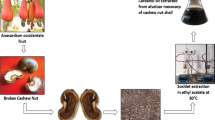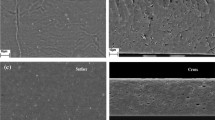Abstract
In this present study the biodegradable PLA/PBAT blend incorporated cardanol oil (CO) along with various nanoparticles (Nps) was fabricated by film casting technique. The primary goal of this work was to address and solve the incompatibility problem that exists between PLA and PBAT blending by introducing green chemical based natural additive cardanol oil as compatibilizer in PLA/PBAT biodegradable polymer blend. The packaging films were developed using various formulations of PLA/PBAT (90/10) biopolymer blend added with cardanol oil as compatibilizing agent and 1wt.% of ZnO, TiO2, and SiO2 as nanofiller. All of the developed PLA/PBAT blended biodegradable films were subjected to various characterizations such as fourier transform infrared spectroscopy, surface and inner morphology, X-ray diffraction, mechanical, thermal degradation, optical, surface hydrophobicity and antibacterial behaviour. The mechanical performance of the prepared film revealed that incorporating 1wt.% NPs (ZnO, TiO2, and SiO2) along with 5wt.% cardanol oil into the composite film improves tensile strength and percentage of elongation. The PLA/PBAT blended film containing both NPs and cardanol oil has a lower OTR and WVTR value and indicating that the flexible film has good barrier properties. The presence of both cardanol oil and NPs in the PLA/PBAT improved the optical properties and surface hydrophobicity. Finally, based on the experimental results obtained in this study, it is inferred that the PLA/PBAT/NPs/CO biodegradable films have high potential for the use in food packaging applications due to their improved packaging performances such as film flexibility, less water permeability, heat withstand ability, less water absorptiveness and good antimicrobial properties.
Similar content being viewed by others
Data Availability
No data available to deposit as private. There are no rights
References
Han Y, Shi J, Mao L, Wang Z, Zhang L (2020) Improvement of compatibility and mechanical performances of PLA/PBAT composites with epoxidized soybean oil as compatibilizer. Ind Eng Chem Res 59(50):21779–21790
Jaillet F, Darroman E, Boutevin B, Caillol S (2016) A chemical platform approach on cardanol oil: from the synthesis of building blocks to polymer synthesis. OCL - Oilseeds Fats Crops Lipids 23(5):511–518
Sharma S, Barkauskaite S, Duffy B, Jaiswal AK, Jaiswal S (2020) Characterization and antimicrobial activity of biodegradable active packaging enriched with clove and thyme essential oil for food packaging application. Foods 9(8):1117
Hernández-López M, Correa-Pacheco ZN, Bautista-Baños S, Zavaleta-Avejar L, Benítez-Jiménez JJ, Sabino-Gutiérrez MA, Ortega-Gudiño P (2019) Bio-based composite fibers from pine essential oil and PLA/PBAT polymer blend. Morphological, physicochemical, thermal and mechanical characterization. Mater Chem Phys 234:345–353
Raja V, Natesan R, Thendral Thiyagu P (2015) Preparation and mechanical properties of poly (butylene adipate-co-terephthalate) polyvinyl alcohol/SiO2 nanocomposite films for packaging applications. J Polym Mater 32(1):93–101
Correa-Pacheco ZN, Black-Solís JD, Ortega-Gudiño P, Sabino-Gutiérrez MA, Benítez-Jiménez JJ, Barajas-Cervantes A, Bautista-Baños S, Hurtado-Colmenares LB (2020) Preparation and characterization of bio-based PLA/PBAT and cinnamon essential oil polymer fibers and life-cycle assessment from hydrolytic degradation. Polymers 12(1):38
Sharma S, Jaiswal AK, Duffy B, Jaiswal S (2020) Ferulic acid incorporated active films based on poly (lactide)/poly (butylene adipate-co-terephthalate) blend for food packaging. Food Packag Shelf Life 24
Rigoussen A, Verge P, Raquez JM, Habibi Y, Dubois P (2017) In-depth investigation on the effect and role of cardanol in the compatibilization of PLA/ABS immiscible blends by reactive extrusion. Eur Polym J 93:272–283
Fu Y, Wu G, Bian X, Zeng J, Weng Y (2020) Biodegradation behavior of poly (Butylene Adipate-Co-Terephthalate)(PBAT), poly (Lactic Acid)(PLA), and Their blend in freshwater with sediment. Molecules 25(17):3946
Barbosa, Josiane Dantas Viana et al (2019). Bionanocomposites of PLA/PBAT/organophilic clay: preparation and characterization. Polímeros [online]. v. 29, n. 3, e2019045. Available from: . Epub 04 Nov 2019. ISSN 1678-5169.https://doi.org/10.1590/0104-1428.09018. [Accessed 1 December 2021]
Irshad M, Subhani MA, Ali S, Hussain A (2020) Biological importance of essential oils. Essential Oils-Oils of Nature
da Silva JMF, Soares BG (2021) Epoxidized cardanol-based prepolymer as promising biobased compatibilizing agent for PLA/PBAT blends. Polym Test 93:106889
Wang B, Jin Y, Yang N, Weng Y, Huang Z, Men S (2020) Investigation on compatibility of PLA/PBAT blends modified by epoxy-terminated branched polymers through chemical micro-crosslinking. e-Polymers 20(1):39–54
Aliotta L, Gigante V, Acucella O, Signori F, Lazzeri A (2020) Thermal, mechanical and micromechanical analysis of PLA/PBAT/POE-g-GMA extruded ternary blends. Front Mater
Gan ZH, Kuwabara K, Yamamoto M, Abe H, Doi Y (2004) Solid-state structures and thermal properties of aliphatic-aromatic poly(butylene adipate-co-butylene terephthalate) copolyesters. Polym Degrad Stabil 83:289–300 (Search in Google Scholar)
Lin S, Guo W, Chen C, Ma J, Wang B (2012) Mechanical properties and morphology of biodegradable poly(lactic acid)/poly(butylene adipate-co-terephthalate) blends compatibilized by transesterification. Mater Des 36:604–608 (Search in Google Scholar)
Weng YX, Jin YJ, Meng QY, Wang L, Zhang M, Wang YZ (2013) Biodegradation behavior of poly(butylene adipate-co-terephthalate) (PBAT), poly(lactic acid) (PLA), and their blend under soil conditions. Polym Test 32:918–926
Al-Itry R, Lamnawar K, Maazouz A (2014) Rheological, morphological, and interfacial properties of compatibilized PLA/PBAT blends. Rheol Acta 53:501–517
Jaillet F, Darroman E, Boutevin B, Caillol S (2016) A chemical platform approach on cardanol oil: from the synthesis of building blocks to polymer synthesis. OCL Oilseeds Fats Crops Lipids 23(5):511–518
Noshirvani N, Ghanbarzadeh B, Gardrat C, Rezaei M, Hashemi M, Le Coz C, Coma V (2017) Cinnamon and ginger essential oils to improve antifungal, physical and mechanical properties of chitosan-carboxymethyl cellulose films. Food Hydrocoll 70:36–45
Khaleque M, Keya C, Hasan K, Hoque M, Inatsu Y, Bari M (2016) Use of cloves and cinnamon essential oil to inactivate Listeria monocytogenes in ground beef at freezing and refrigeration temperatures. LWT-Food Sci Technol 74:219–223
Marcet I, Weng S, Sáez-Orviz S, Rendueles M, Díaz M (2018) Production and characterisation of biodegradable PLA nanoparticles loaded with thymol to improve its antimicrobial e_ect. J Food Eng 239:26–32
Prakash VR, Arun, Viswanathan R (2019) Fabrication and characterization of silanized echinoidea fillers and kenaf fibre-reinforced Azadirachta-indica blended epoxy multi-hybrid biocomposite. Int J Plast Technol 23(2):207–217
Prakash VR, Arun J, Xavier F, Ramesh G, Maridurai T, Siva Kumar K, Blessing Sam Raj R (2020) Mechanical, thermal and fatigue behaviour of surface-treated novel Caryota urens fibre–reinforced epoxy composite. Biomass Convers Biorefin: 1–11
Rajadurai A (2016) Thermo-mechanical characterization of siliconized E-glass fiber/hematite particles reinforced epoxy resin hybrid composite. Appl Surf Sci 384:99–106
Ben Samuel J, Julyes Jaisingh S, Sivakumar K, Mayakannan AV, Arunprakash VR (2021) Visco-elastic, thermal, antimicrobial and dielectric behaviour of areca fibre-reinforced nano-silica and neem oil-toughened epoxy resin bio composite. Silicon 13(6):1703–1712
Greco A, Maffezzoli A (2018) Cardanol derivatives as innovative bio-plasticizers for poly (lactic acid). Polym Degrad Stabil 132:213–219. https://doi.org/10.1016/j.polymdegradstab.2016.02.020
Miele G, Bloise E, Cosemtino F, Lomonaco D, Avelino F, Marciano T, Massaro C, Mazzetto SE, Tammaro L, Scalone AG, Schioppa M, Terzi R (2019) Influence of cardanol oil on the properties of poly(lactic acid) films produced by melt extrusion. ACS Omega 4:718–726. https://doi.org/10.1021/acsomega.8b02880
Hang H, Li Y, Gong M, Guo Y, Guo Z, Fang Q, Li X (2018) An environmentally sustainable plasticizer toughned polylactide. RSC Adv 8:116–143. https://doi.org/10.1039/c7ra13448g
Gu W, Liu X, Li F, Shi SQ, Xia C, Zhou W, … Li J (2019) Tough, strong,and biodegradable composite film with excellent UV barrier performance comprising soy protein isolate, hyperbranched polyester, and cardanol derivative. Green Chem 21(13):3651-3665
Lee S, Park MS, Shin J, Kim YW (2018) Effect of the individual and combined use of cardanol-based plasticizers and epoxidized soybean oil on the properties of PVC. Polym Degrad Stabil 147:1–11. https://doi.org/10.1016/j.polymdegradstab.2017.11.002
Greco A, Ferrari F, Maffezzoli A (2019) Mechanical properties of poly (lactid acid) plasticized by cardanol derivatives. Polym Degrad Stab 159:199–204
Cranston E, Kawada J, Raymond S, Morin FG, Marchessault RH (2003) Cocrystallization Model For Synthetic Biodegradable Poly(Butylene Adipate-Co-Butylene Terephthalate). Biomacromolecules 4:995–999. https://doi.org/10.1021/bm034089n
Wang X, Huang L, Zhang C, Deng Y, Xie P, Liu L, Cheng J (2020) Research advances in chemical modifications of starch for hydrophobicity and its applications: A review. Carbohydr Polym 240:116292
Seong DM, Lee H, Kim J, Jeong Ho C (2020) High oxygen and water-vapor transmission rate and in vitro cytotoxicity assessment with illite-polyethylene packaging films. Materials 13(10):2382
Lian S, Jintong Z, Jiangyong W, Xu C, Swart HC, Terblans JJ (2021) A Model for adsorption and diffusion in water vapor barrier films. Phys Status Solidi (B) 258(6):2000609
Ma J, Cahill DG, Miljkovic N (2020) Condensation induced blistering as a measurement technique for the adhesion energy of nanoscale polymer films. Nano Lett 20(5):3918–3924
Chavoshizadeh S, Pirsa S, Mohtarami F (2020) Conducting/smart color film based on wheat gluten/chlorophyll/polypyrrole nanocomposite. Food Packag Shelf Life 24:100501
Soliman TS, Sergey AV, Elkalashy SI (2020) Structural, thermal, and linear optical properties of SiO2 nanoparticles dispersed in polyvinyl alcohol nanocomposite films. Polym Compos 41(8):3340–3350
Thendral TT, Sai Prasanna Kumar JV, Sathiyamoorthy V, Arun Prakash VR (2021) Effect of cashew shell biomass synthesized cardanol oil green compatibilizer on flexibility, barrier, thermal, and wettability of PLA/PBAT biocomposite films. Biomass Convers Biorefin: 1–11
Mizielińska M, Kowalska U, Jarosz M, Sumińska P, Landercy N, Duquesne E (2018) The effect of UV aging on antimicrobial and mechanical properties of PLA films with incorporated zinc oxide nanoparticles. Int J Environ Res Public Health 15(4):794
Hasheminya S-M, Mokarram RR, Ghanbarzadeh B, Hamishekar H (2018) Physicochemical, mechanical, optical, microstructural and antimicrobial properties of novel kefiran-carboxymethyl cellulose biocomposite films as influenced by copper oxide nanoparticles (CuONPs). Food Packag Shelf Life 17:196–204
Atarés L, Chiralt A (2016) Essential oils as additives in biodegradable films and coatings for active food packaging. Trends Food Sci Technol 48:51–62
Author information
Authors and Affiliations
Contributions
All have done equal contribution.
Corresponding author
Ethics declarations
Yes this article compliance with ethical standards of journal
Conflicts of Interest/Competing Interests
There is no conflict of interest by any form for this manuscript
Consent to Participate
Yes. All permission granted
Consent for Publication
Yes. All permission granted
Additional information
Publisher’s Note
Springer Nature remains neutral with regard to jurisdictional claims in published maps and institutional affiliations.
Rights and permissions
About this article
Cite this article
Thiyagu, T.T., Gokilakrishnan, G., Uvaraja, V.C. et al. Effect of SiO2/TiO2 and ZnO Nanoparticle on Cardanol Oil Compatibilized PLA/PBAT Biocomposite Packaging Film. Silicon 14, 3795–3808 (2022). https://doi.org/10.1007/s12633-021-01577-4
Received:
Accepted:
Published:
Issue Date:
DOI: https://doi.org/10.1007/s12633-021-01577-4




